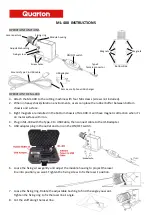
2.1 Controls
The indicators are controlled and calibrated via four
front panel push buttons located below the display.
In the display mode i.e. when the indicator is
displaying a process variable, these push buttons
have the following functions:
P
While this button is pushed the indicator
will display the input current in mA, or as a
percentage of the instrument span
depending upon how the indicator has
been configured. When the button is
released the normal display in engineering
units will return. The function of this push
button is modified when optional alarms
are fitted to the indicator.
▼
While this button is pushed the indicator
will display the numerical value and
analogue bargraph* the indicator has been
calibrated to display with a 4mA
Φ
input.
When released the normal display in
engineering units will return.
▲
While this button is pushed the indicator
will display the numerical value and
analogue bargraph* the indicator has been
calibrated to display with a 20mA
Φ
input.
When released the normal display in
engineering units will return.
E
No function in the display mode unless the
tare function is being used.
P +
▼
Firmware number followed by version.
P +
▲
Direct access to the alarm setpoints when
optional alarms are fitted to the indicator
and the ‘ACSP’ access setpoints in display
mode function has been enabled.
P + E
Access to configuration menu via optional
security code.
Note:
*
BA527E-SS
only
Φ
If the indicator has been calibrated
using the CAL function, calibration
points may not be 4 and 20mA.
3. APPLICATIONS
3.1 Transmitter loops
Both models may be connected in series with any
4/20mA current loop and calibrated to display the
measured variable or control signal in engineering
units.
Figs 2 illustrate a typical application in which an
indicator is connected in series with a 2-wire
transmitter.
Fig 2 Indicator in a transmitter loop
Considering the example shown in Fig 2, the sum
of the maximum voltage drops of all the
components in the loop must be less than the
minimum power supply voltage.
Minimum operating voltage of 2-wire Tx
10.0
Maximum voltage drop caused by controller
5.0
Maximum voltage drop caused by BA507E-SS 1.3
Maximum voltage caused by cables
0.4
_____
16.7V
Therefore in this example the power supply must
have a minimum output of 16.7V at 20mA.
3.2 Remote indication
Both indicators may be driven from a 4/20mA
signal to provide a remote indication. Fig 3 shows
a typical application in which the 4/20mA output
from a gas analyser is connected to a BA507E-SS
loop powered indicator to provide a remote
indication of the analyser’s output. Again it is
necessary to ensure that the voltage capability of
the 4/20mA source is greater than the sum of the
voltage drops introduced by the indicator and the
cable resistance.
4





































